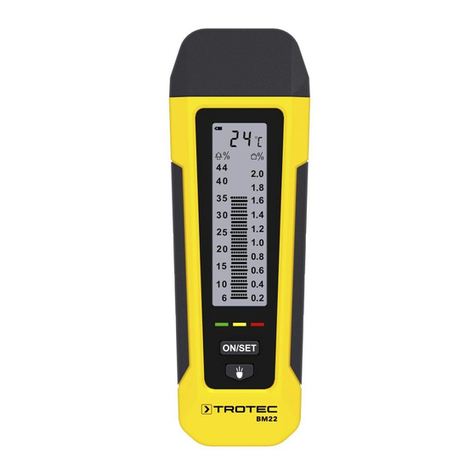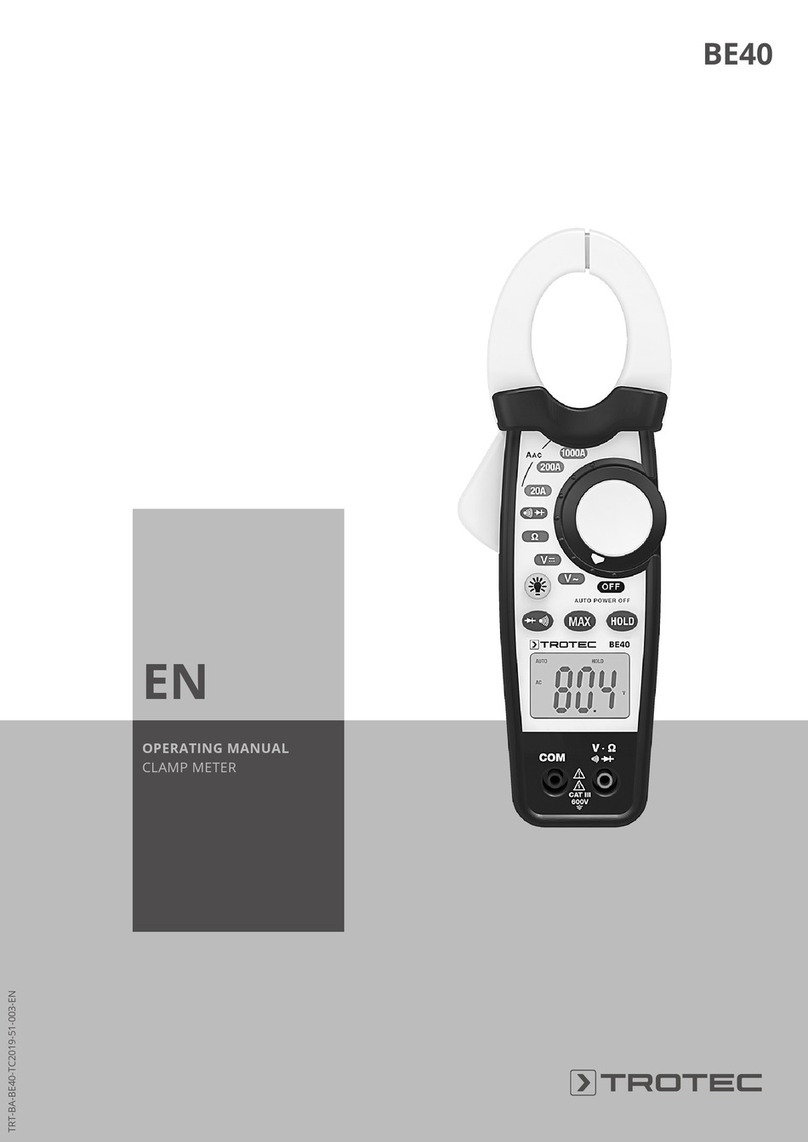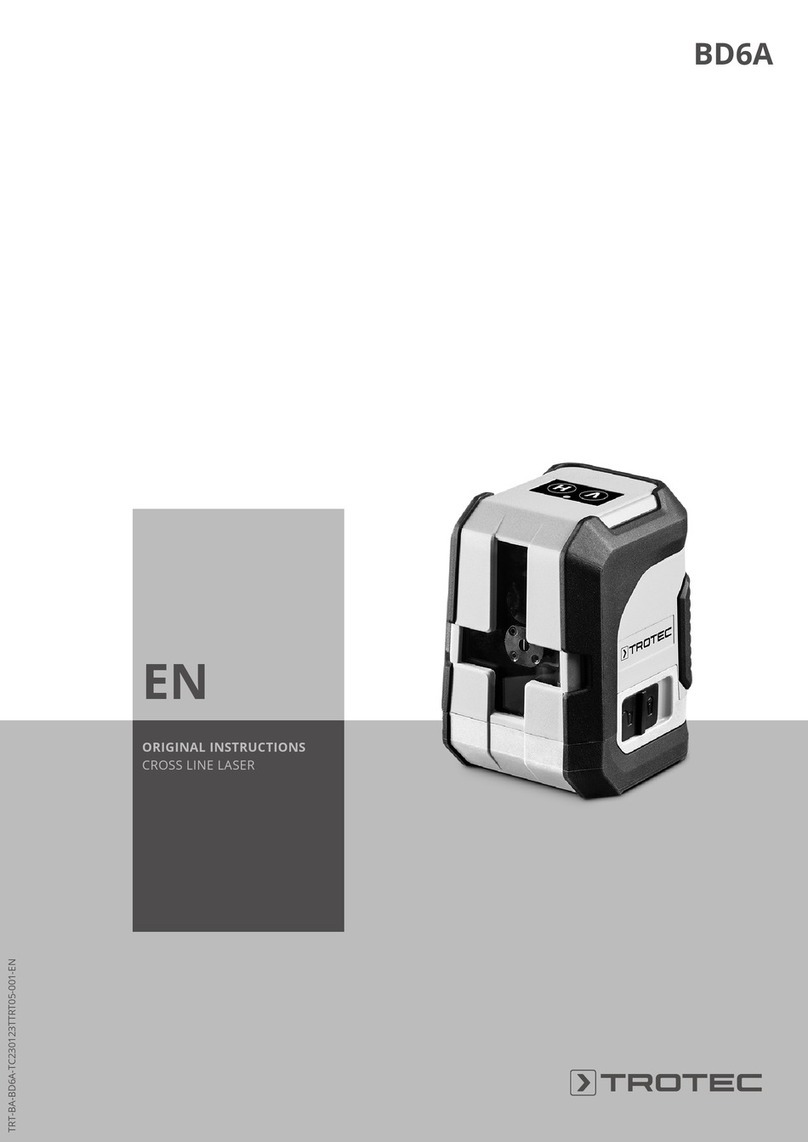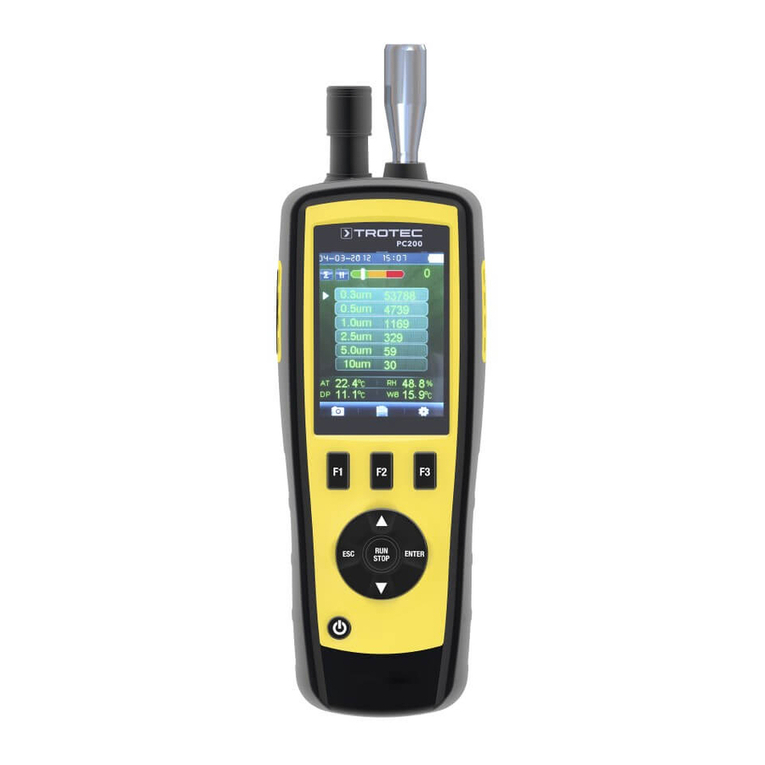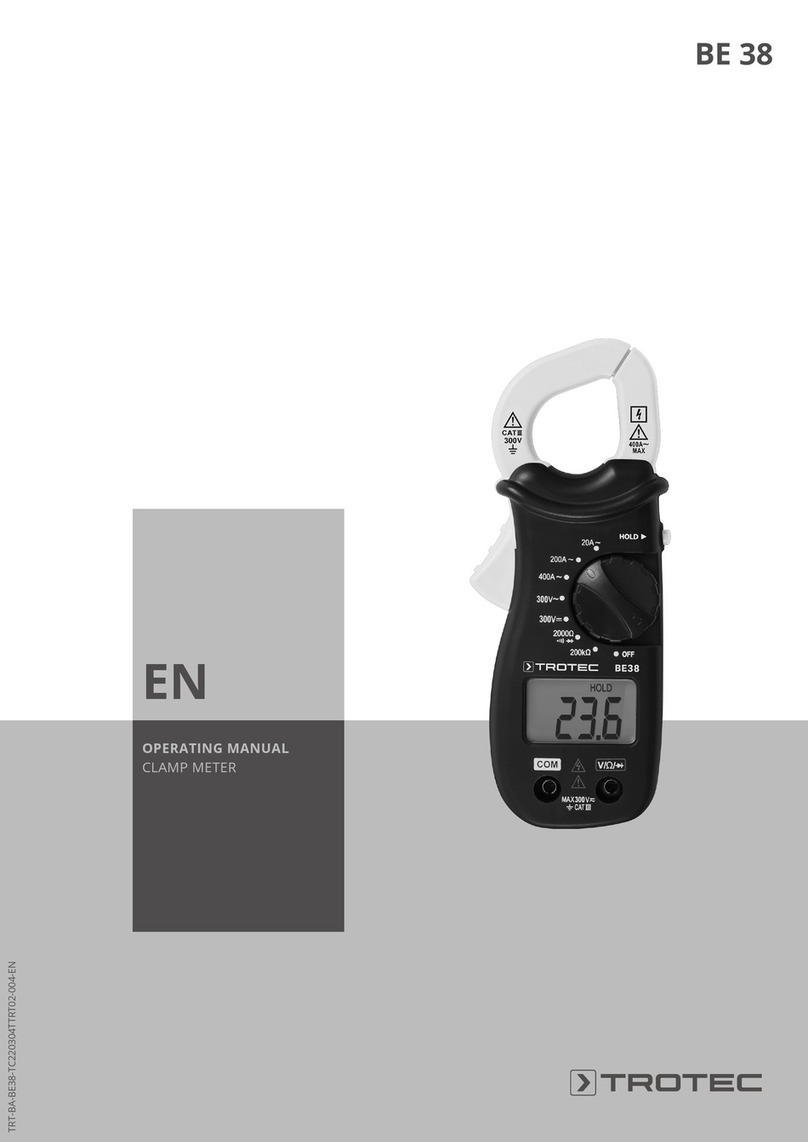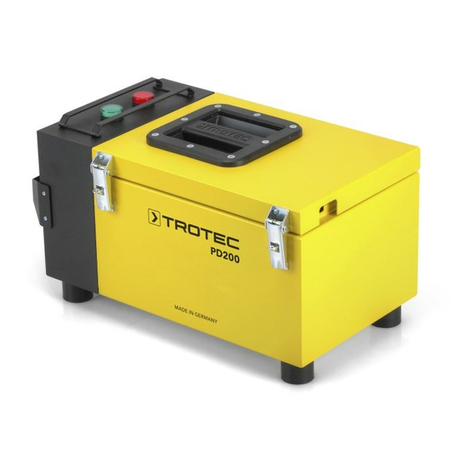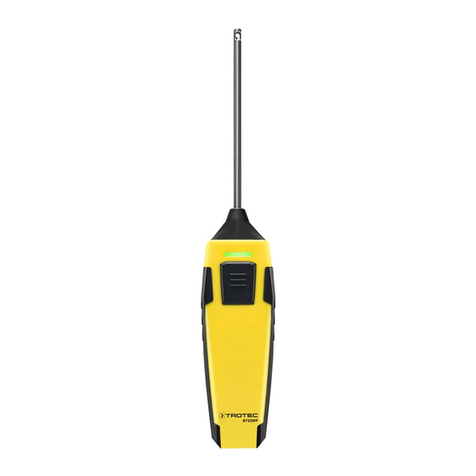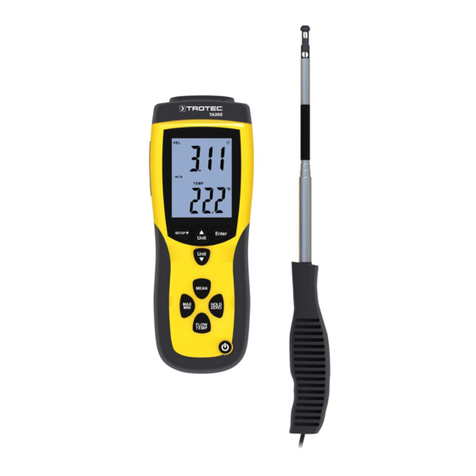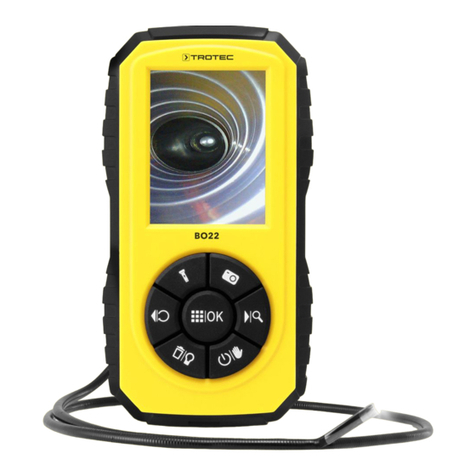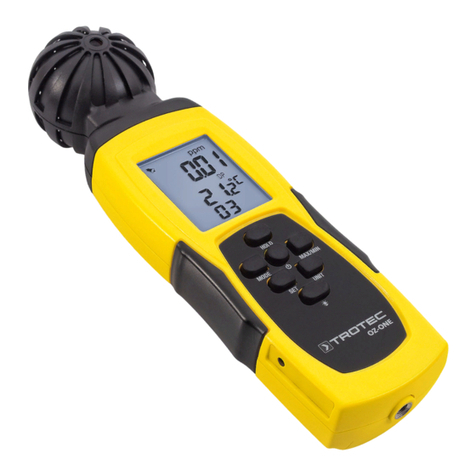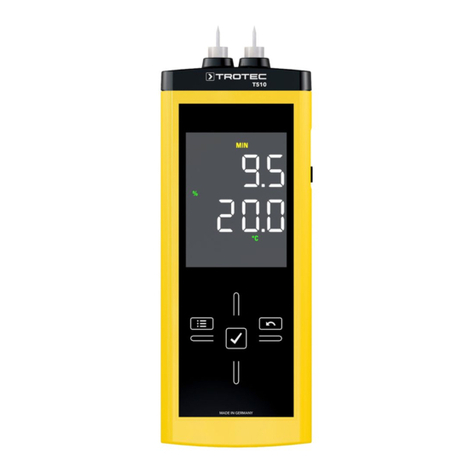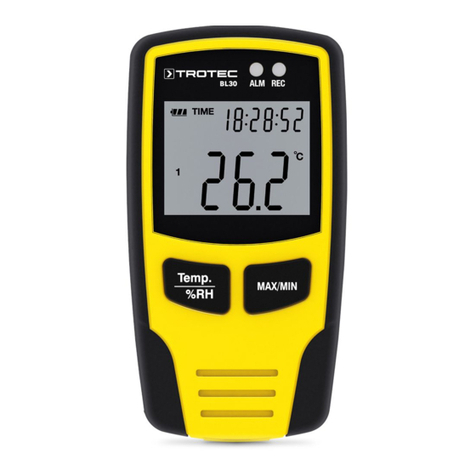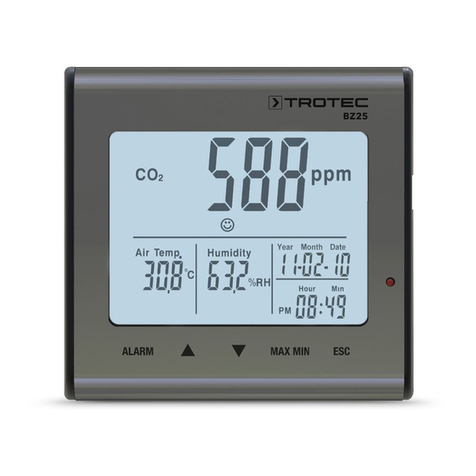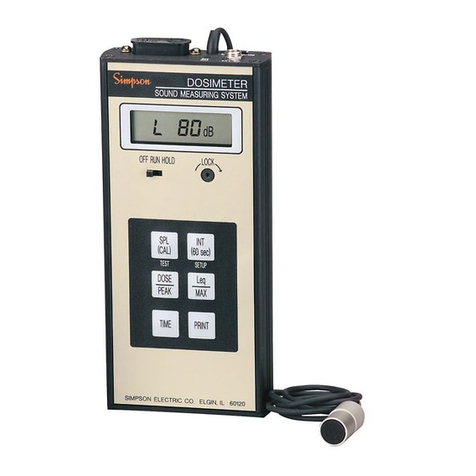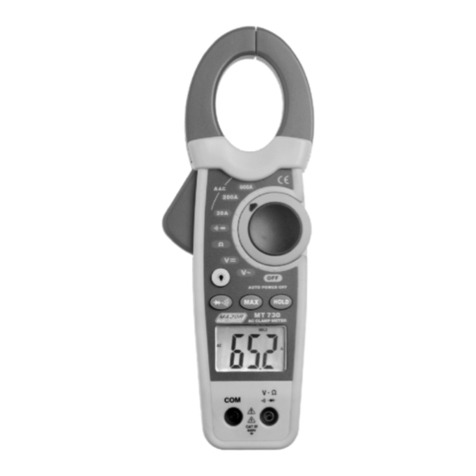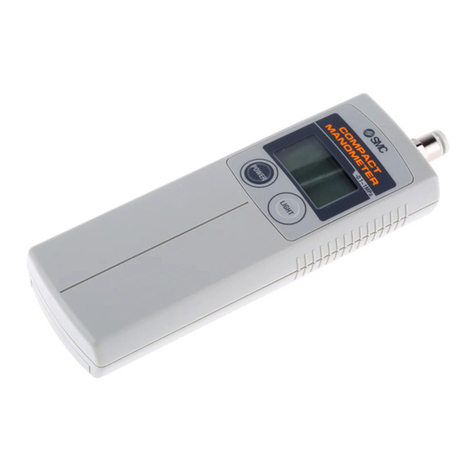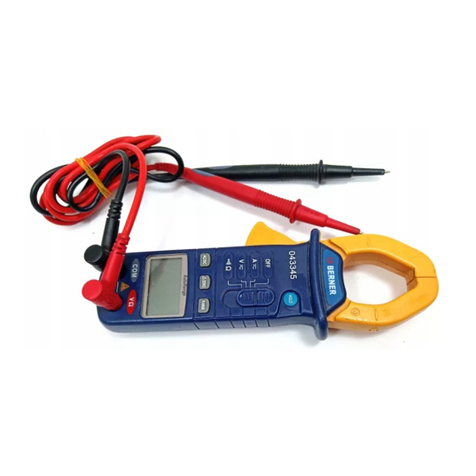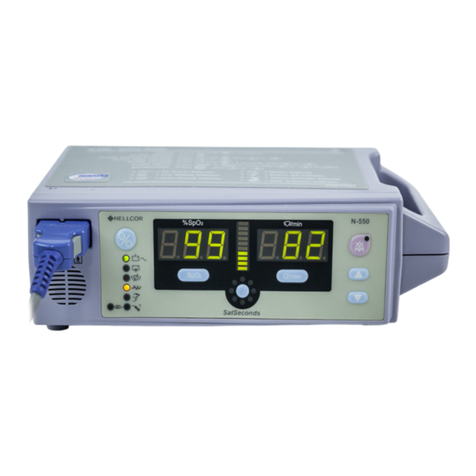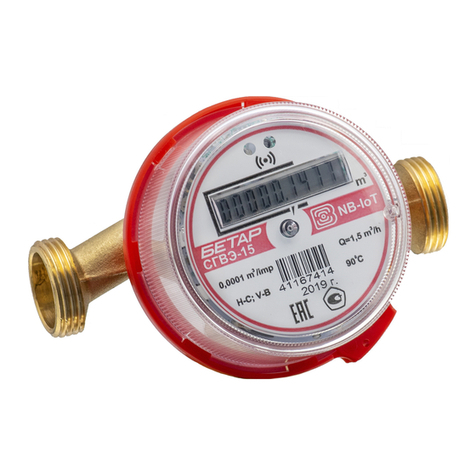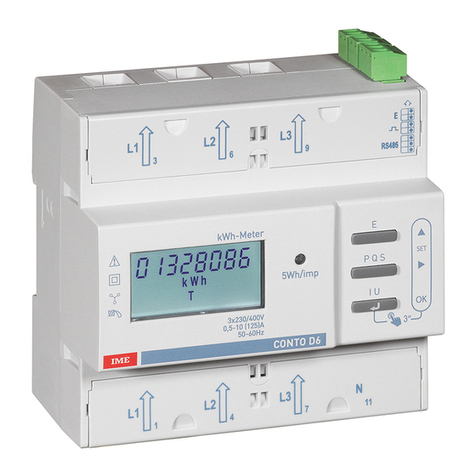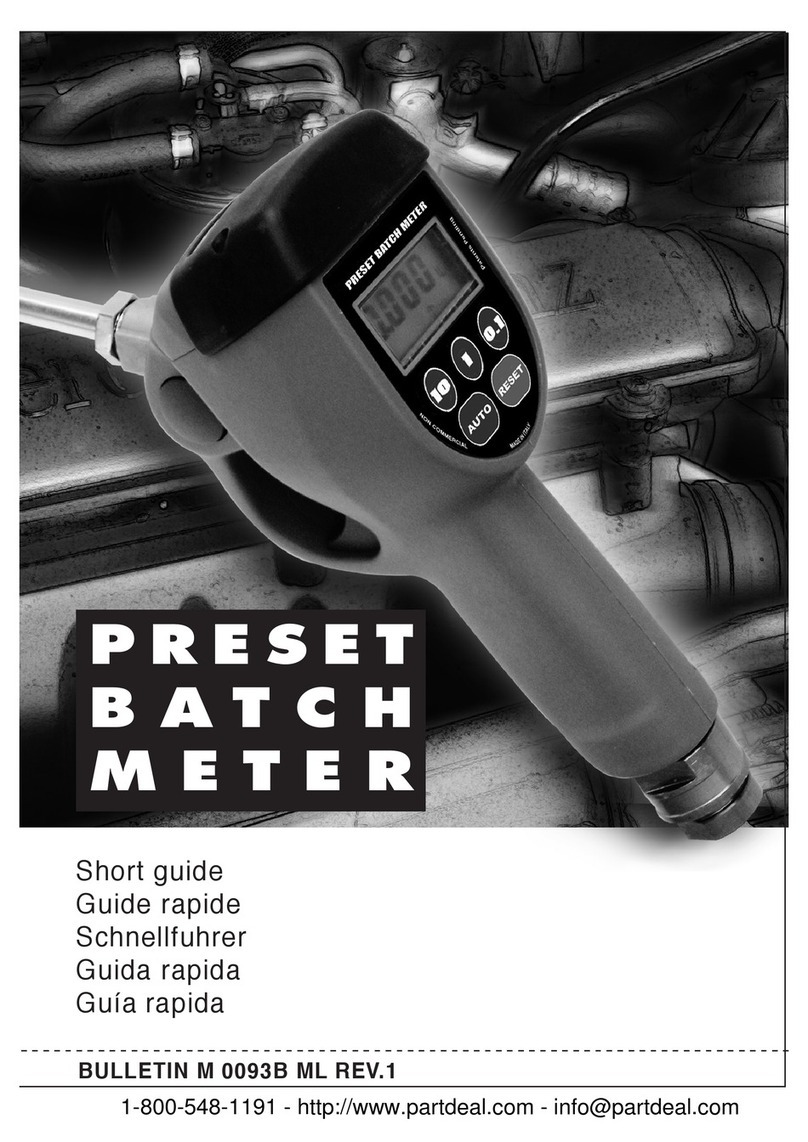Trotec TD200 User manual

TRT-BA-TD200-TC220304TTRT01-001-EN
TD200
EN
OPERATING MANUAL
LASER DISTANCE MEASURING
DEVICE

2 EN
laser distance measuring device TD200
Table of contents
Notes regarding the operating manual.................................2
Safety .....................................................................................2
Information about the device................................................4
Transport and storage...........................................................6
Operation ...............................................................................7
Maintenance and repair ......................................................14
Errors and faults..................................................................15
Disposal ...............................................................................15
Declaration of conformity ...................................................16
Notes regarding the operating manual
Symbols
Warning of electrical voltage
This symbol indicates dangers to the life and health of
persons due to electrical voltage.
Warning of laser radiation
This symbol indicates dangers to the health of persons
due to laser radiation.
Warning
This signal word indicates a hazard with an average
risk level which, if not avoided, can result in serious
injury or death.
Caution
This signal word indicates a hazard with a low risk
level which, if not avoided, can result in minor or
moderate injury.
Note
This signal word indicates important information (e.g.
material damage), but does not indicate hazards.
Info
Information marked with this symbol helps you to carry
out your tasks quickly and safely.
Follow the manual
Information marked with this symbol indicates that the
operating manual must be observed.
You can download the current version of the operating manual
and the EU declaration of conformity via the following link:
TD200
https://hub.trotec.com/?id=46393
Safety
Read this manual carefully before starting or using the
device. Always store the manual in the immediate vicinity
of the device or its site of use.
Warning
Read all safety warnings and all instructions.
Failure to follow the warnings and instructions may
result in electric shock, fire and/or serious injury.
Save all warnings and instructions for future
reference.
Danger
If non-rechargeable batteries are used, connecting the
device to a power supply (also for data exchange) via a
USB cable or via wireless charging may cause the
batteries to burst, damage the device or cause fire and
injuries.
Therefore, only use rechargeable batteries if
possible!
However, if you need to use non-rechargeable
batteries for a short time for technical reasons, it is
mandatory to remove the non-rechargeable batteries
from the device before connecting it to a computer or a
charger!
• Do not use the device in potentially explosive rooms or
areas and do not install it there.
• Do not use the device in aggressive atmosphere.
• Do not immerse the device in water. Do not allow liquids to
penetrate into the device.
• The device may only be used in dry surroundings and must
not be used in the rain or at a relative humidity exceeding
the operating conditions.
• Protect the device from permanent direct sunlight.
• Do not remove any safety signs, stickers or labels from the
device. Keep all safety signs, stickers and labels in legible
condition.
• Do not open the device.
• Avoid looking directly into the laser beam.
• Never point the laser beam at people or animals.

EN 3
laser distance measuring device TD200
• Different types of batteries and new and used batteries
must not be used together.
• Insert the batteries into the battery compartment according
to the correct polarity.
• Remove the batteries from the device if you will not be
using the device for a longer period of time.
• Never short-circuit the supply terminal in the battery
compartment!
• Do not swallow batteries! If a battery is swallowed, it can
cause severe internal burns within2hours! These burns
can lead to death!
• If you think batteries might have been swallowed or
otherwise entered the body, seek medical attention
immediately!
• Keep new and used batteries and an open battery
compartment away from children.
• Only use the device, if sufficient safety precautions were
taken at the surveyed location (e.g. when performing
measurements along public roads, on building sites etc.).
Otherwise do not use the device.
• Observe the storage and operating conditions (see
Technical data).
Intended use
Only use the device for measuring distances, areas and volumes
by means of the integrated laser and within the measuring
range specified in the technical data. Observe and comply with
the technical data.
To use the device for its intended use, only use accessories and
spare parts which have been approved by Trotec.
Foreseeable misuse
Do not use the device in potentially explosive atmospheres, or
for measurements in liquids. Never point it at people or animals.
Do not connect the device to a charger or computer using a
USBcable if non-rechargeable batteries are inserted into the
device.
Any unauthorised modifications, alterations or structural
changes to the device are forbidden.
Personnel qualifications
People who use this device must:
• be aware of the dangers that occur when working with
laser measuring devices.
• have read and understood the operating manual, especially
the Safety chapter.
Safety signs and labels on the device
Note
Do not remove any safety signs, stickers or labels from
the device. Keep all safety signs, stickers and labels in
legible condition.
The following safety signs and labels are attached to the device:
Warning sign
Meaning The warning sign is located on the back of the
device and indicates that the device is equipped
with a class2 laser.
The power is less than 1.0mW. The frequency
range of the laser is630 to 670nm.
Do not look directly into the laser beam or
the opening from which the laser beam
emerges!
Residual risks
Warning of laser radiation
Laser class2, Pmax.: <1mW, λ: 400-700nm,
EN60825-1:2014
Do not look directly into the laser beam or the opening
from which it emerges.
Never point the laser beam at people, animals or
reflective surfaces. Even brief eye contact can lead to
eye damage.
Examining the laser output aperture by use of optical
instruments (e.g. magnifying glass, magnifiers and the
like) entails the risk of eye damage.
When working with a laser of class2, observe the
national regulations on wearing eye protection.
Warning
Risk of suffocation!
Do not leave the packaging lying around. Children may
use it as a dangerous toy.
Warning
The device is not a toy and does not belong in the
hands of children.
Warning
Dangers can occur at the device when it is used by
untrained people in an unprofessional or improper way!
Observe the personnel qualifications!
Caution
Keep a sufficient distance from heat sources.

4 EN
laser distance measuring device TD200
Note
To prevent damages to the device, do not expose it to
extreme temperatures, extreme humidity or moisture.
Note
Do not use abrasive cleaners or solvents to clean the
device.
Information about the device
Device description
The laser distance measuring deviceTD200 is used to
determine distances, areas and volumes in indoor and outdoor
areas. The following measuring functions can be performed:
• Distance measurements (to a point or between two points)
• Continuous measurements (measuring minimum and
maximum distances)
• Area measurements (rectangular, triangular and measuring
circles)
• Volume measurements (rectangular or cylindrical)
• Height measurements, also of partial heights/indirect
measurements
• Measurements of trapezoid sides
• Marking repetitive distances (stake-out function)
The device is equipped with an integrated camera that allows
you to search for the target point and take a photo of the
measurement situation.
The timer allows to perform delayed measurements
after5seconds.
The device is equipped with separate operating elements for the
different measuring functions. The multi-line, backlit display
indicates the determined values and measuring functions.
Measured values can be added or subtracted and up
to1000measurements can be retrieved from the data memory.
Measuring distance
The range of the device can be gathered from the Technical
data chapter. Under certain conditions – e.g. at night, in twilight
or when the target is hidden in the shade – greater distances
are possible even without target plate. During the day use a
target plate to increase the distance for poorly reflecting targets,
if required.
Target surfaces
There might be measurement errors when the laser encounters
colourless liquids (e.g. water), dust-free glass, styrofoam or
other semi-permeable materials. The measurement result may
also be falsified if the laser encounters a high-gloss surface and
is deflected by it. Non-glossy, non-reflective or dark surfaces
can extend the measurement duration.
Wireless charging
You have the option to charge the device wirelessly. To do so,
you require an inductive charger (5V, 1A/5A) which is not
included in the scope of delivery.
Device depiction
1
2
3
4
5
6
7
8
9
10
11
No. Designation
1 Display
2SETbutton
3
MEAS
button
4 Cover of the battery compartment
5 Camera opening
6 Laser
7 Laser reception
8 Opening for carrying strap
9 Tripod connection
10 USB port
11 Keypad

EN 5
laser distance measuring device TD200
Keypad
13
12
14
15
16
17
No. Butto
n
Function
12 Press briefly: switches on the camera
when in settings menu: changes the menu item
when in memory: opens the Delete menu
Press for a long time: for taking a photo with a
single distance measurement
13 Press briefly: switches on the laser/performs
measurement
Press and hold: continuous measurement
14 Press briefly: initiates an addition of a measured
value
when in measuring menu/settings menu: changes
the submenu
when in memory mode: selects the next memory
point
15 Press briefly: deletes last value/back to single
distance measurement
Press for a long time: switches the device on and
off
16 Press briefly: initiates a subtraction of a measured
value
when in measuring menu/settings menu: changes
the submenu
when in memory mode: selects the previous
memory point
Press for a long time: opens the memory mode
17 Press briefly: opens the measuring menu
when in memory mode: changes between data
values and photos
when in settings menu: changes the submenu
Press and hold: time-delayed measurement(5s)
Display
18
19
20
21
22
23
No. Display element
18 Indication of the measuring function used
19 Digital display of inclination angle
20 Measured value and result display
21 Graphic display of inclination angle
22 Indication of the set reference point
23 Battery status

6 EN
laser distance measuring device TD200
Technical data
Parameter Value
Model TD200
Weight (incl. batteries) 190g
Dimensions (Hx Wx D) 130 x 54x 28mm
Measuring range of laser 0.05m to 200m/
2in to 656ft
Display 3-inch HD colour display
Measuring units m/mm/ft/in/ft+in
Accuracy ±2.0mm+ 5 x 10-5 D
Measuring range resolution 1 mm
Reference point at measuring
device
front/rear/tripod
Number of recordings logged in
the history
Max. 1000
Number of storable screenshots Max. 100
Operating temperature 0°C to 40°C
32°F to 104°F
Storage temperature -10 °C to 60 °C
Relative humidity max. 90%
Laser output <1mW (630-670nm)
Laser class II
Device switch-off After approx. 3minutes of
non-use
Automatic switch-off of the laser After approx. 30seconds of
non-use
Protection class IP 65
USB port MicroUSB
Power supply 3x 1.2V rechargeable
batteries (typeAAA)
Wireless charging 5V, 1A/5A
Scope of delivery
• 1x Device TD200
• 3x rechargeable batteries 1.2VAAA
• 1 x Wrist strap
• 1x Bag/holster
• 1 x USB cable
• 1x screwdriver
• 1 x Quick guide
Transport and storage
Note
If you store or transport the device improperly, the
device may be damaged.
Note the information regarding transport and storage of
the device.
Transport
For transporting the device, use the bag included in the scope of
delivery in order to protect the device from external influences.
Storage
When the device is not being used, observe the following
storage conditions:
• dry and protected from frost and heat
• protected from dust and direct sunlight
• with a cover to protect it from invasive dust if necessary
• the storage temperature complies with the values specified
in the Technical data
• Remove the batteries from the device.

EN 7
laser distance measuring device TD200
Operation
Inserting the batteries
Danger
If non-rechargeable batteries are used, connecting the
device to a power supply (also for data exchange) via a
USB cable or via wireless charging may cause the
batteries to burst, damage the device or cause fire and
injuries.
Therefore, only use rechargeable batteries if
possible!
However, if you need to use non-rechargeable
batteries for a short time for technical reasons, it is
mandatory to remove the non-rechargeable batteries
from the device before connecting it to a computer or a
charger!
Note
Make sure that the surface of the device is dry and the
device is switched off.
1. Loosen the cover of the battery compartment(4) with a
screwdriver.
2. Insert three rechargeable batteries of typeAAA (1.2V,
included in the scope of delivery) into the battery
compartment with correct polarity (+/-).
3. Put the cover of the battery compartment back onto the
device and tighten it with the screws.
Switch-on
1. Press the button(15) for approx.1second.
ðThe display will be activated and the device is in single
distance measurement mode.
ðThe display indicates the inclination angle digitally in
degrees and graphically by means of a bar on the left
edge of the display.
Basic settings
1. Press the SETbutton(2) to open the menu for the settings.
ðThe menu items that can be selected are indicated on
the right of the display.
ðThe possible options for the menu item are indicated on
the left side.
You can make the following settings:
Measuring unit : metres– three decimal places
: metres– four decimal places
: millimetres
: foot
: inch
: foot and inch
Reference point : front edge of device
: rear edge of device
: centre of tripod connection
Screen rotation : screen rotation enabled
: screen rotation disabled
Sounds : acoustic signal enabled
: acoustic signal disabled
Menu languages : English
EN
中
: Chinese
Display background
MEAS
: white background
MEAS
: black background
Time-delayed
measurement
: starts a time-delayed
measurement(5s)
Memory : opens the memory for measurements
and photos
Measurement
constant
: opens the menu for setting a base value
that is added or subtracted when measuring
1. Use the button(14) and the button(12) to switch
between the menu items.
2. Use the button(16) and the button(17) to switch
between the submenu options.
3. Press the button(13) to select the option highlighted in
the submenu.
ðThe selected option is adopted and displayed in the
menu item on the right.
4. Press the button(15) to exit the settings menu and
return to the measuring menu.

8 EN
laser distance measuring device TD200
Selecting the measuring function
Press the button(17) to open the menu for the measuring
functions. You can select the measuring functions with the
button(14) or the button(16) and confirm with
the button(13).
The following measuring functions are available:
Single distance measurement:
- you can add or subtract measured values
- continuous measurements (measuring minimum or
maximum distances)
Area measurements (rectangle)
Volume measurements (cube)
Point-to-point measurement
Stake-out function (mark equal distances)
Measuring circular areas
Measuring cylinder volumes
Measuring triangular areas
Trapezoidal measurement2 (through one height and
a diagonal)
Trapezoidal measurement1 (through two heights and
a baseline)
Automatic height measurements
Levelled distance/height and angle measurements
Measuring partial heights over three points
(Pythagoras2, 3-point)
Measuring heights over three points
(Pythagoras1, 3-point)
Measuring heights over two points
(Pythagoras2-point)
By pressing the button (15) you can exit the measuring
function and return to the individual measurement mode.
Carrying out measurements
Warning of laser radiation
Laser class2, Pmax.: <1mW, λ: 400-700nm,
EN60825-1:2014
Do not look directly into the laser beam or the opening
from which it emerges.
Never point the laser beam at people, animals or
reflective surfaces. Even brief eye contact can lead to
eye damage.
Examining the laser output aperture by use of optical
instruments (e.g. magnifying glass, magnifiers and the
like) entails the risk of eye damage.
When working with a laser of class2, observe the
national regulations on wearing eye protection.
Info
The device is equipped with two buttons that can be
used to start the distance measurement:
- button13) below the display
-
MEAS
button(3) on the right side
In this manual, only the button(13) is mentioned in
the following for simplification. Depending on the
measurement situation, you can use the button that is
easier for you to use.
Aiming at the target:
If the laser is not visible at the measuring point, you can activate
the camera by pressing the button(12). The camera has a
viewfinder function that places crosshairs on the laser dot which
allows you to aim at the target very precisely. By pressing
the button(13) you can start the distance measurement of
the targeted point. Afterwards, the display switches back to the
measuring menu.

EN 9
laser distance measuring device TD200
Single distance measurement
1. Briefly press the button(13) to activate the laser.
2. Point the laser at the target area.
3. Briefly press the button(13) again to perform a distance
measurement.
ðThe measured value is indicated on the display.
a
Info
In single distance measurement mode, you can
activate the camera function by pressing
the button(12). By pressing again for
approx.3seconds, a photo is taken and saved together
with the measured value.
Continuous measurement (min./max.)
With this measurement method the device can be moved during
the measurement with the measured value being recalculated
roughly every 0.5seconds. You can use the function for
performing the following measurements, for example:
•MIN value: determining the perpendicular length to a wall/
floor area
•MAX value: measuring a diagonal
üYou have selected the single distance measuring function.
1. Press the button(13) and keep it pressed.
ðWith activated signal indication function, a recurring
acoustic signal is emitted.
ðThe maximum, minimum and current value are
indicated on the display.
2. Depending on the desired measurement, move the device
slowly forwards, backwards, up or down (e.g. in the corner
of a room).
3. Briefly press the button to terminate the non-stop
measurement.
ðThe maximum, minimum and last measured value are
indicated on the display.
Area measurements (rectangle)
üYou have selected the area measuring function.
1.
Briefly press the button(13) to carry out measurement
1
.
ðThe length of the distance is indicated on the display.
2. Turn the device by90° and press the button(13) again
briefly to perform measurement
2
.
ðUpon pressing the button for the second time the
device independently calculates the area(S) and the
circumference and indicates these values on the
display.
Volume measurements (cube)
üYou have selected the volume measuring function.
1. Briefly press the button(13) to measure length
1
.
ðThe length of the distance is indicated on the display.
2. Briefly press the button again to measure width
2
.
ðThe second measured value is also indicated on the
display.
3. Briefly press the button again to measure height
3
.
ðThe third measured value is also indicated on the
display.
ðThe device automatically calculates the volume and
indicates this value on the display.

10 EN
laser distance measuring device TD200
Point-to-point measurement
After selecting the measuring function “point-to-point
measurement”, the device performs a calibration. You must
hold the device absolutely still to do so. After successful
calibration you can start the measurement:
1. Aim the laser at the starting point and press
the button(13) briefly to perform measurement
1
.
ðThe length of the distance is indicated on the display.
2. Aim the laser at the endpoint and press the button again
briefly to perform measurement
2
.
ðThe second measured value is also indicated on the
display.
ðThe device automatically calculates the distance(L)
between the two measuring points and the angle
between the two measuring distances(α) and indicates
these results on the display.
Marking-out function
This measuring function is used to mark equal distances, e.g.
when assembling construction components. You can enter two
values for the measurement:
• A: the initial value at which the measurement is supposed
to start (e.g. the distance from a wall to the first
construction element)
• B: the recurring distance you would like to mark (e.g. the
distance between individual construction elements).
After selecting the measuring function, the input mask for the
values A and B appears. The following buttons are available for
entering the values:
Button Function
navigate to the left
navigate to the right
increase the value
reduce the value
save displayed value
Exit menu
Info
Before marking, note which reference point is selected!
After the values have been entered, the stake-out function is
started and you can start marking. The indicators on the display
are for your guidance:
• The upper value(24) indicates the distance to a point to be
marked.
• The value in the centre(25) indicates how oftenA andB
have been reached at the current point.
• The lower value(26) indicates the total distance.
• Directional arrows(27) indicate the direction to the closest
point.
24
25
26
27
1. Move the device slowly along the marked line.
ðWhen you approach the point for valueA, acoustic
signal sounds are emitted rapidly (if the acoustic signal
function is switched on).
2. Mark the point when the upper value is zero. The reference
point can be set to the front or the back of the device.
ðThe starting point(A) for the stake-out function is set.
3. Continue to move the device along the marked line.
ðWhen you approach the point for distanceB, acoustic
signal sounds are emitted rapidly (if the acoustic signal
function is switched on).
4.
Mark the point when the upper value is zero.
ðThe first distanceB is now marked.
5. Continue as in steps3 and4 until all desired points have
been marked.

EN 11
laser distance measuring device TD200
Measuring circular areas
üYou have selected the circular area measuring function.
1. Briefly press the button(13) to determine the
diameter(Ø) of the circular area.
ðThe device automatically calculates the size and
circumference of the circular area and indicates the
values on the display.
Ø
Measuring cylinder volumes
üYou have selected the cylinder volume measuring function.
1. Briefly press the button(13) to determine the
diameter(Ø) of the cylinder.
ðThe length of the distance is indicated on the display.
2. Briefly press the button(13) again to measure the
height(h) of the cylinder.
ðThe length of the distance is indicated on the display.
ðThe device automatically calculates the size of the
circular area and the volume of the cylinder and
indicates the values on the display.
Ø
Measuring triangular areas
üYou have selected the triangular area measuring function.
1. Briefly press the button(13) to measure side
1
of the
triangle.
ðThe length of the distance is indicated on the display.
2. Re-align the device and press the button(13) again
briefly to measure side
2
of the triangle.
ðThe length of the distance is indicated on the display.
3. Place the measuring device at the endpoint of side
2
and
press the button(13) again briefly to measure side
3
of
the triangle.
ðThe length of the distance is indicated on the display.
ðThe device automatically calculates the size of the
triangular area(S) and indicates the value on the
display.
Info
If the measured sides cannot form a triangle
mathematically, the display indicates an error
message.
Trapezoidal measurement2
(through one height and a diagonal)
üYou have selected the triangular area2 measuring function.
1. Briefly press the button(13) to measure height
1
of the
trapezoidal area.
ðThe length of the distance is indicated on the display.
2. Re-align the measuring device and press the button(13)
again briefly to measure diagonal
2
of the trapezoidal
area.
ðThe length of the distance is indicated on the display.
ðThe device automatically calculates the length(L) and
the angle(α) between the diagonal and the baseline of
the trapezoidal area and indicates the values on the
display.

12 EN
laser distance measuring device TD200
Trapezoidal measurement1
(through two heights and a baseline)
üYou have selected the triangular area1 measuring function.
1. Briefly press the button(13) to measure height
1
of the
trapezoidal area.
ðThe length of the distance is indicated on the display.
2. Place the measuring device at the endpoint of side2 and
press the button(13) again briefly to measure
baseline
2
of the trapezoidal area.
ðThe length of the distance is indicated on the display.
3. Re-align the measuring device and press the button(13)
briefly to measure the second height
3
of the trapezoidal
area.
ðThe length of the distance is indicated on the display.
ðThe device automatically calculates the missing
length(L) of the triangular area and indicates the value
on the display.
L
Automatic height measurements
üYou have selected the automatic height measuring function.
1. Aim the laser at the upper endpoint and press
the button(13) briefly to perform measurement
1
.
ðThe length of the distance is indicated on the display.
2. Aim the laser at the lower endpoint and press
the button(13) briefly to perform measurement
2
.
ðThe length of the distance is indicated on the display.
ðThe device automatically calculates the height(H) and
indicates this value on the display.
H
Levelled distance/height and angle measurements
üYou have selected the levelled distance/height and angle
measuring function.
1. Aim the laser at the endpoint of the height and press
the button(13) briefly to determine the distance
1
to
the endpoint.
ðThe length of the distance(1) is indicated on the
display.
ðThe device automatically calculates the horizontal
distance(L), the height(H) and the angle(α) and
indicates these values in the display.
L
H
Measuring partial heights over three points
(Pythagoras2, 3-point)
üYou have selected the Pythagoras 2, 3-point measuring
function.
1. Aim the laser at the upper endpoint and press
the button(13) briefly to determine the distance
1
to
the endpoint.
ðThe length of the distance is indicated on the display.
2. Aim the laser at the lower point of the partial height and
press the button(13) briefly to determine the
distance
2
to the lower point of the partial height.
ðThe length of the distance is indicated on the display.
3. Aim the laser at the base point (at a 90° angle to the
partial height) and press the button(13) briefly to
determine the distance
3
to the base point.
ðThe length of the distance is indicated on the display.
ðThe device automatically calculates the height(H) and
indicates this value on the display.
H

EN 13
laser distance measuring device TD200
Measuring heights over three points
(Pythagoras1, 3-point)
üYou have selected the Pythagoras 1, 3-point measuring
function.
1. Aim the laser at the upper endpoint and press
the button(13) briefly to determine the distance
1
to
the endpoint.
ðThe length of the distance is indicated on the display.
2. Aim the laser at the point at the centre of the height (at a
90° angle to the height) and press the button(13)
briefly to determine the distance
2
to the point at the
centre of the height.
ðThe length of the distance is indicated on the display.
3. Aim the laser at the lower endpoint of the height and press
the button(13) briefly to determine the distance
3
to
the lower endpoint.
ðThe length of the distance is indicated on the display.
ðThe device automatically calculates the height(H) and
indicates this value on the display.
H
Measuring heights over two points
(Pythagoras2-point)
üYou have selected the Pythagoras 2-point measuring
function.
1. Aim the laser at the upper endpoint and press
the button(13) briefly to determine the distance
1
to
the endpoint.
ðThe length of the distance is indicated on the display.
2. Aim the laser at the lower endpoint of the height (at a
90° angle to the height) and press the button(13)
briefly to determine the distance
2
to the lower endpoint.
ðThe length of the distance is indicated on the display.
ðThe device automatically calculates the height(H) and
indicates this value on the display.
H
Adding/ subtracting measured values
Info
You can add or subtract measured values when using
the following measuring functions:
- single distance measurements
- area measurements
- volume measurements
Setting the measurement constant
You have the option of setting a measurement constant on the
device (see Making Basic Settings) and subtracting this set
value from the measured value or adding it. Please proceed as
follows to set the measurement constant:
üThe Measuring constant menu item in the settings menu
must be activated.
üThe menu for setting the measurement constant has
opened.
1. Set the value for the measurement constant and activate
the use of the measurement constant with the following
buttons:
Button Function
navigate to the left
navigate to the right
increase the value
reduce the value
save displayed value
Exit menu
Delayed measurement
There are two ways to trigger a time-delayed single distance
measurement of 5seconds:
• Open the settings menu with the SETbutton, navigate to
the time-delayed measurement (see chapter Basic
settings) and start the time-delayed measurement with
the button(13).
• Press and hold the button(17) for a long time

14 EN
laser distance measuring device TD200
Display saved measured values and photos
The device automatically saves the last 1000measured values
and up to100photos.
There are two ways to access the memory:
• Open the settings menu with the SETbutton, navigate to
the memory function (see chapter Basic settings) and
press the button(13) to open the memory.
• Press and hold the button(16) for a long time
1. Briefly press the button(17) to switch between the
measured value memory and the photo memory.
2. Press the button(14) to access the next data point.
3. Press the button(16) to return to the previous data
point.
4. Press the button(12) to open the menu for deleting
saved data.
ðIn the Delete menu you have the option of deleting all
data values or the data value currently displayed.
ðYou can use the button(14) or the button(16) to
switch between the displayed options.
ðYou can press the button(13) to select the displayed
option and delete data.
ðPress the button(15) to exit the Delete menu and
return to the memory.
Loading measured values and photos to a computer
Danger
If non-rechargeable batteries are used, connecting the
device to a power supply (also for data exchange) via a
USB cable or via wireless charging may cause the
batteries to burst, damage the device or cause fire and
injuries.
Therefore, only use rechargeable batteries if
possible!
However, if you need to use non-rechargeable
batteries for a short time for technical reasons, it is
mandatory to remove the non-rechargeable batteries
from the device before connecting it to a computer or a
charger!
You have the option to transmit any stored photos and
measured values to a computer. To do so, connect the device to
a computer via the USBcable. The measured values can be
found in the Excel file displayed, the photos are stored in the
IMG folder.
Switch-off
1. Press the button(15) for a long time.
ðThe display is switched off.
Maintenance and repair
Charging the batteries
Recharge the rechargeable batteries once the battery status
indicator(23) indicates that the batteries are empty or if the
device can no longer be switched on. Ideally, the rechargeable
batteries are always charged on a suitable USB port/charger by
means of the charging cable included in the scope of delivery.
1. Plug the charging cable into a suitable USB port or into a
charger with a USB output. Only use the original charging
cable or one with identical specifications.
2.
Open the protective cover for the micro USB connection(10)
at the device.
3. Connect the charger to the micro USB connection.
I.
II.
23
4. Disconnect the charging cable again once the battery
status indication(23) shows a charged battery.
Info
You also have the option to charge the device
wirelessly. To do so, you require a suitable inductive
charger ((5V, 1A/5A), not included in the scope of
delivery).
Danger
If non-rechargeable batteries are used, connecting the
device to a power supply (also for data exchange) via a
USB cable or via wireless charging may cause the
batteries to burst, damage the device or cause fire and
injuries.
Therefore, only use rechargeable batteries if
possible!
However, if you need to use non-rechargeable
batteries for a short time for technical reasons, it is
mandatory to remove the non-rechargeable batteries
from the device before connecting it to a computer or a
charger!

EN 15
laser distance measuring device TD200
Changing rechargeable batteries
To replace the batteries, proceed as described in the chapter
Operation under Inserting the batteries. Remove the old
batteries before inserting the new ones.
Cleaning
Clean the device with a soft, damp and lint-free cloth. Make
sure that no moisture enters the housing. Do not use any
sprays, solvents, alcohol-based cleaning agents or abrasive
cleaners, but only clean water to moisten the cloth.
Repair
Do not modify the device or install any spare parts. For repairs
or device testing, contact the manufacturer.
Errors and faults
The device has been checked for proper functioning several
times during production. If malfunctions occur nonetheless,
check the device according to the following list.
The following fault indications may appear on the display:
Display Cause Remedy
204 Calculation error Repeat the measurement. Pay
attention to the measurement
sequence and position of the
device.
208 Excessive power
consumption
Please contact the Trotec
customer service.
220 The batteries are
almost empty.
Change the batteries, see
chapter Battery change.
255 The reception of the
reflected signal is too
weak.
Repeat measurement on
another surface with better
reflective properties or use a
target plate.
256 The reception of the
reflected signal is too
strong.
261 Range exceeded Observe the range values
specified in the Technical data
chapter.
500 Hardware fault Repeatedly switch the device
on and off. If the indication
continues to appear, please
contact the Trotec customer
service.
Disposal
Always dispose of packing materials in an environmentally
friendly manner and in accordance with the applicable local
disposal regulations.
The icon with the crossed-out waste bin on waste
electrical or electronic equipment stipulates that this equipment
must not be disposed of with the household waste at the end of
its life. You will find collection points for free return of waste
electrical and electronic equipment in your vicinity. The
addresses can be obtained from your municipality or local
administration. You can also find out about other return options
that apply for many EU countries on the website
https://hub.trotec.com/?id=45090. Otherwise, please contact an
official recycling centre for electronic and electrical equipment
authorised for your country.
The separate collection of waste electrical and electronic
equipment aims to enable the re-use, recycling and other forms
of recovery of waste equipment as well as to prevent negative
effects for the environment and human health caused by the
disposal of hazardous substances potentially contained in the
equipment.
In the European Union, batteries and accumulators must
not be treated as domestic waste, but must be disposed of
professionally in accordance with Directive 2006/66/EC of the
European Parliament and of the Council of 6September2006
on batteries and accumulators. Please dispose of batteries and
accumulators according to the relevant legal requirements.
Only for United Kingdom
According to Waste Electrical and Electronic Equipment
Regulations 2013 (SI2013/3113) (as amended) and the Waste
Batteries and Accumulators Regulations 2009 (SI2009/890) (as
amended), devices that are no longer usable must be collected
separately and disposed of in an environmentally friendly
manner.

16 EN
laser distance measuring device TD200
Declaration of conformity
We– Trotec GmbH– declare in sole responsibility that the
product designated below was developed, constructed and
produced in compliance with the requirements of the EU Radio
Equipment Directive in the version 2014/53/EU.
Product model/ Product: TD200
Product type: laser distance measuring
device
Year of manufacture as of: 2022
Relevant EUdirectives:
• 2011/65/EU
• 2012/19/EU
Applied harmonised standards:
• EN 300 328 V2.2.2:2019-07
• EN 55032:2015
• EN 55032:2015/A11:2020-03
• EN 55035:2017
• EN 60825-1:2014
• EN 61326-2-1:2013
• EN 61326-2-2:2013
Applied national standards and technical specifications:
• Regulation (EC) 1907/2006
• EN 301 489-1 V2.2.3:2019-11
• EN 301 489-3 V2.1.1
• EN 303 417 V1.1.1:2017-9
• EN 50663:2017-10
• EN 50665:2017
• EN 55035:2017/A11:2020-05
• EN 61010-1:2010
• EN 61010-1:2010/A1:2019-02
• EN62321-1:2013
• EN62321-2:2014
• EN62321-3-1:2014
• EN62321-4:2014
• EN 62321-4:2014/A1:2017-11
• EN62321-5:2014
• EN62321-6:2015
• EN62321-7-1:2015
• EN62321-7-2:2017
• EN62321-8:2017
• EN 62479:2010
• IEC 60529:1989/AMD1:1999
• IEC 60529:1989/AMD2:2013
• IEC 60825-1:2014
• IEC 61010-1:2010
• IEC 61010-1:2010/AMD1:2016
Manufacturer and name of the authorised representative of
the technical documentation:
Trotec GmbH
Grebbener Straße 7, D-52525 Heinsberg
Phone: +49 2452 962-400
E-mail: [email protected]
Place and date of issue:
Heinsberg, 25.05.2022
Joachim Ludwig, Managing Director

Trotec GmbH
Grebbener Str. 7
D-52525 Heinsberg
+49 2452 962-400
+49 2452 962-200
www.trotec.com
Table of contents
Other Trotec Measuring Instrument manuals
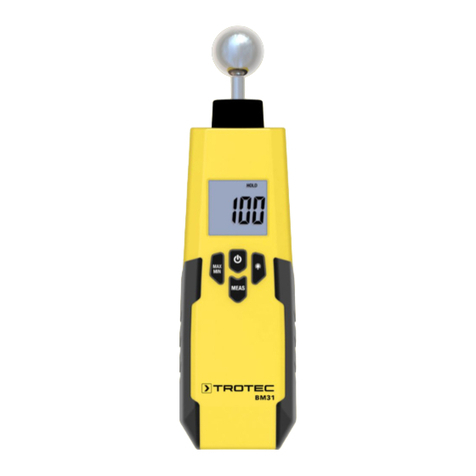
Trotec
Trotec BM31-XT User manual
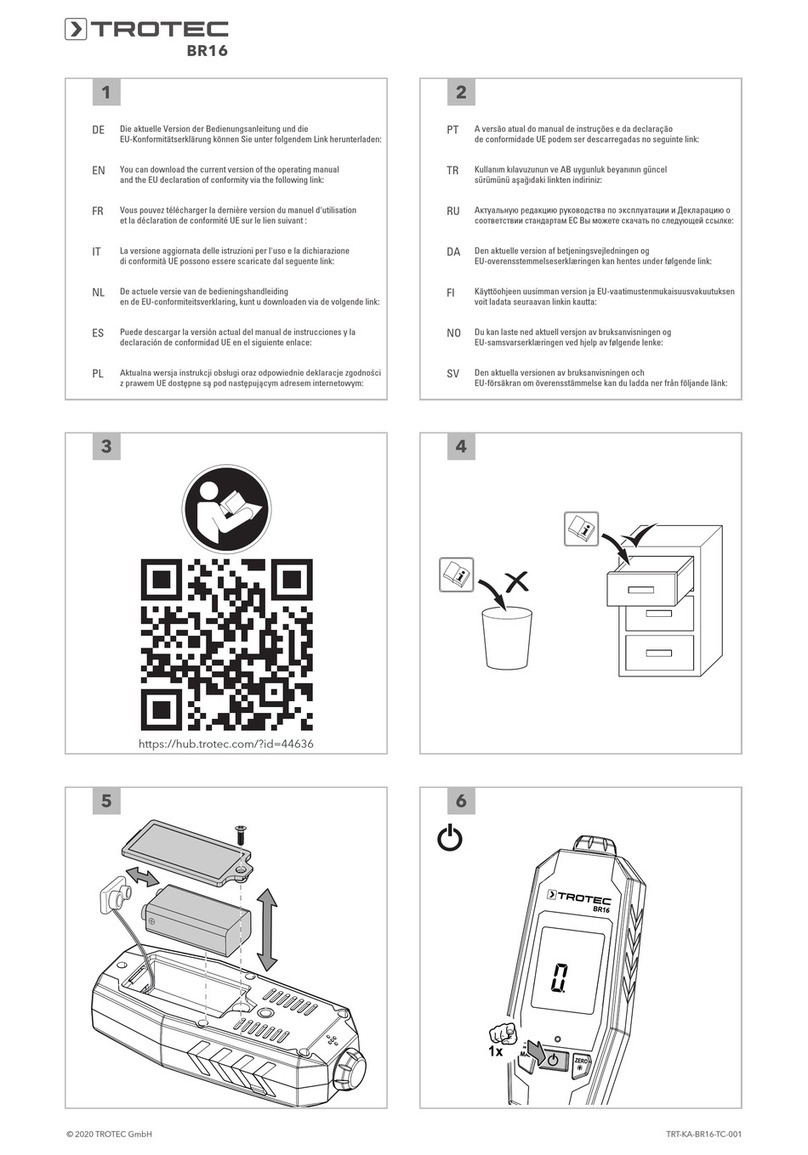
Trotec
Trotec BR16 User manual

Trotec
Trotec BA30WP User manual
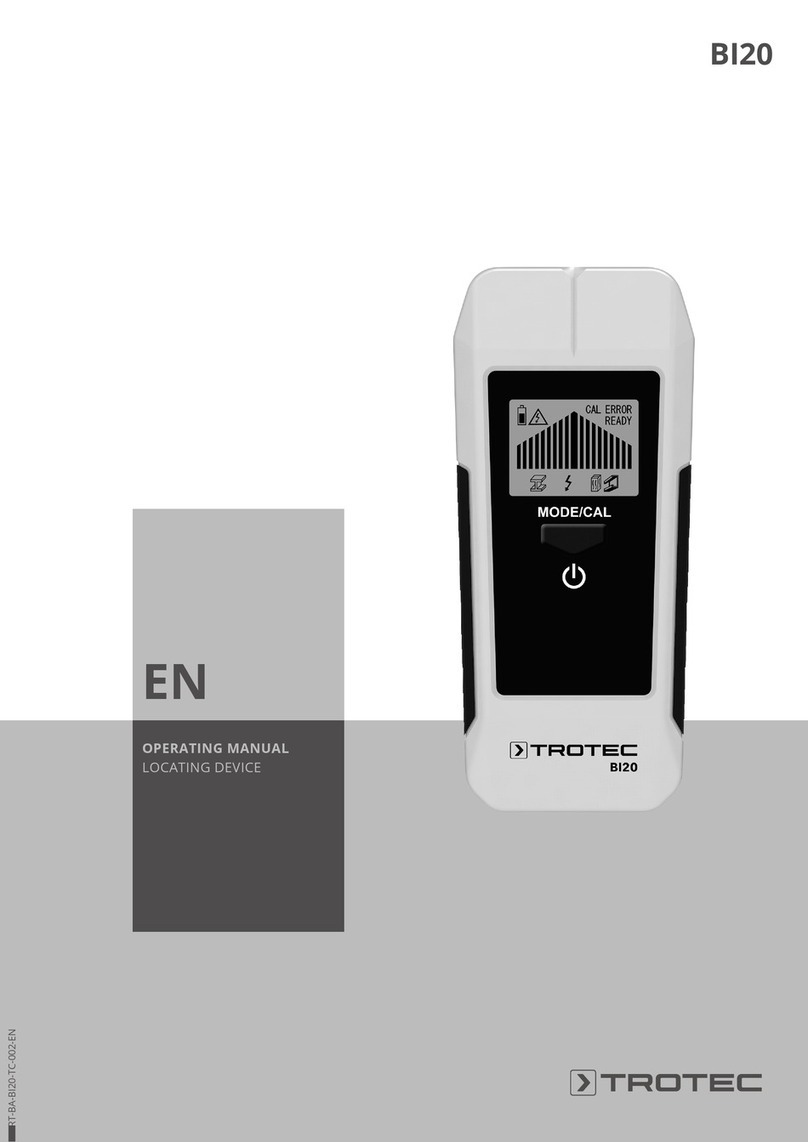
Trotec
Trotec BI20 User manual
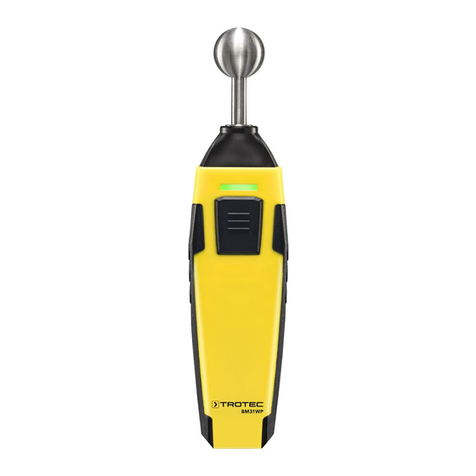
Trotec
Trotec BM31WP User manual
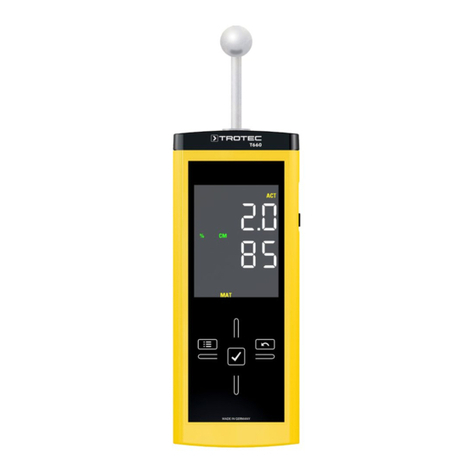
Trotec
Trotec T660 User manual

Trotec
Trotec BP21WP User manual

Trotec
Trotec BE 38 User manual

Trotec
Trotec BZ15M User manual
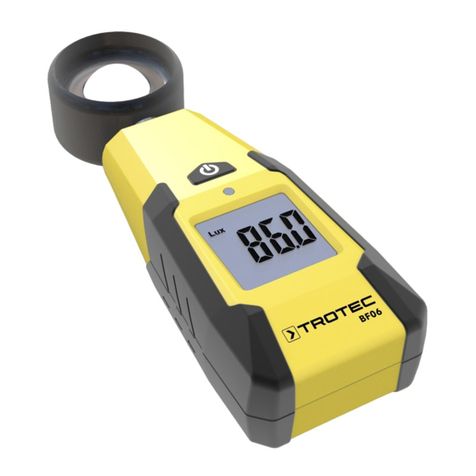
Trotec
Trotec BF06 User manual
Popular Measuring Instrument manuals by other brands
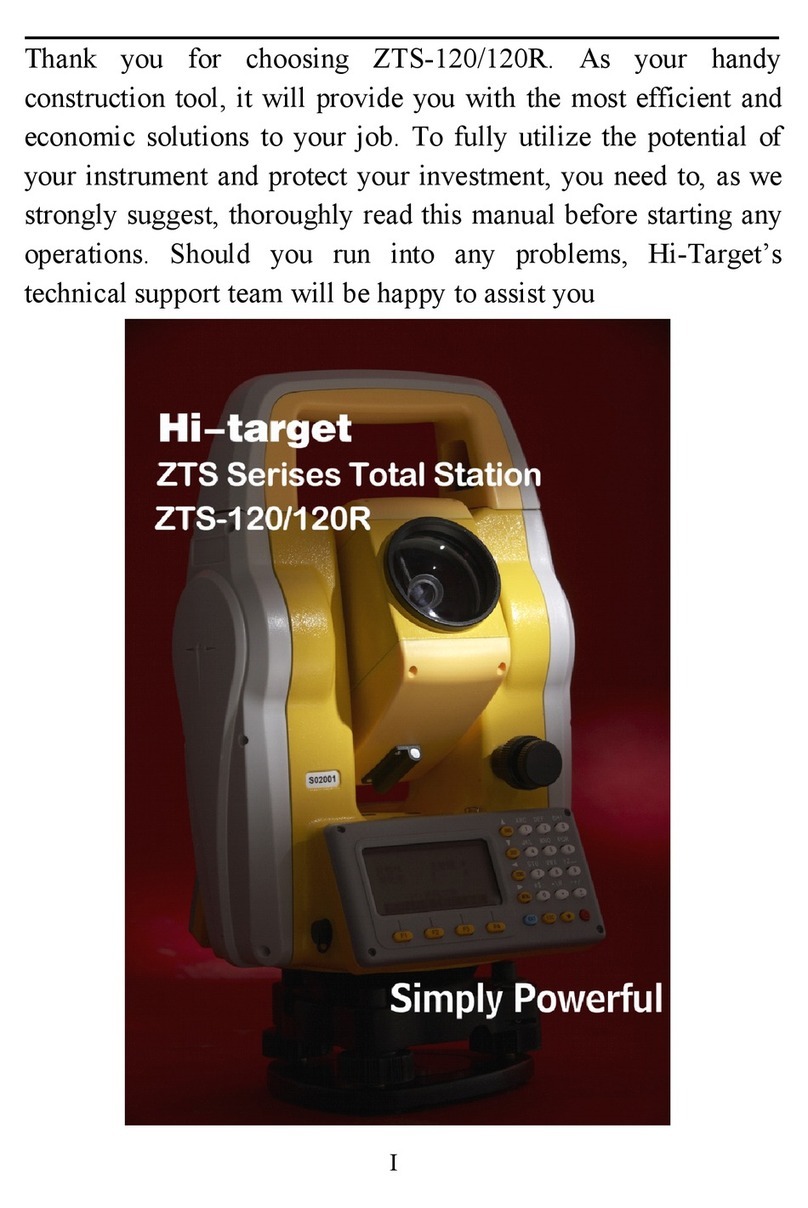
Hi-Target
Hi-Target ZTS-120 user manual
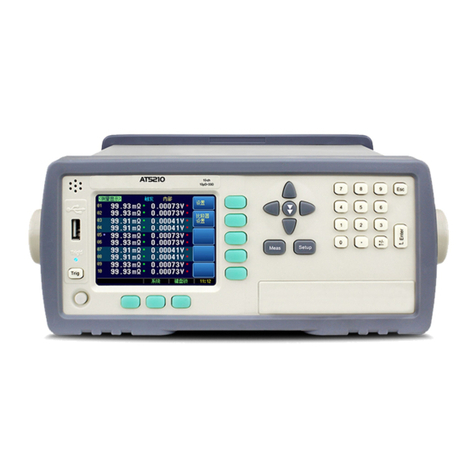
Applent Instruments
Applent Instruments AT5210 user guide

Tonghui Electronics
Tonghui Electronics TH1991 Operation manual

Hioki
Hioki IM7580A-1 Communication instruction manual
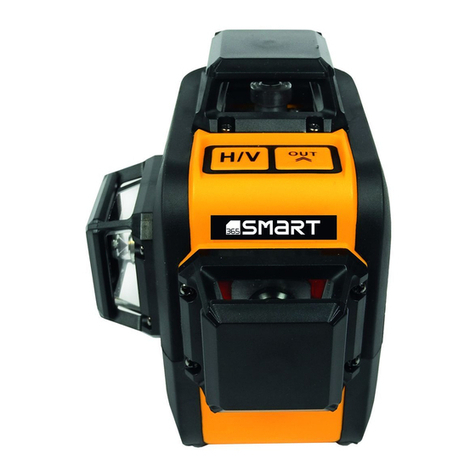
SMART365
SMART365 SM-06-03015R user manual
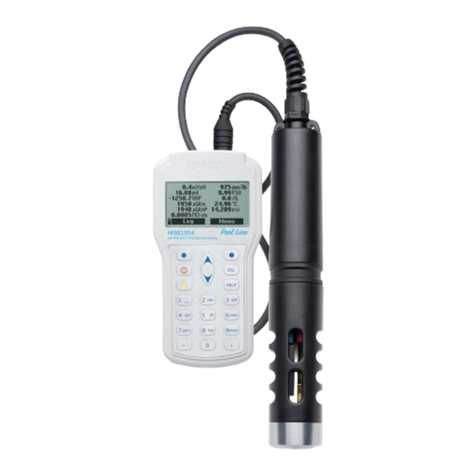
Hanna Instruments
Hanna Instruments HI981954 instruction manual
